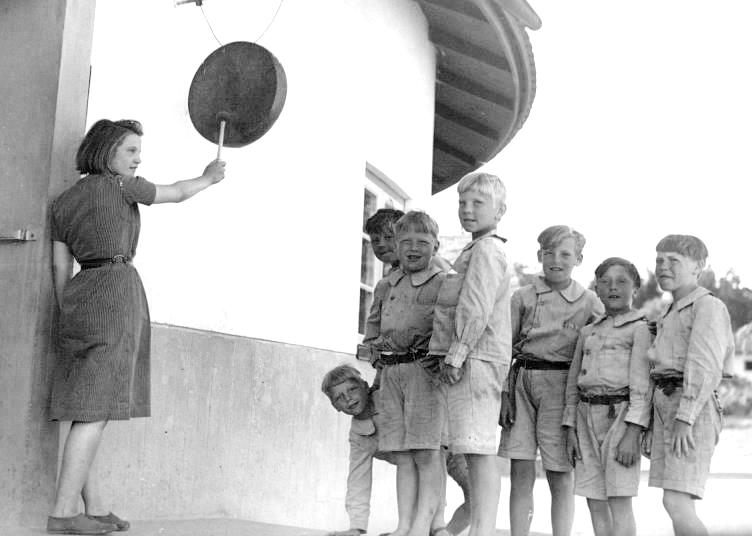
Swedish Boys' Institutions Charities

Figure 1.-- This is a scene at the Freemason Children's Home near Stockhom in 1939. The boys had a uniform with a side buttoning blouse, large collar and short pants. It was a group of buildings in the Blackeberg district, Bromma in Stockholm municipality. The buildings are designed in Swedish 1920s classicism by the architect Hakon Ahlberg. At the onset of World War II, the Swedish miltart nearly took them over for signals intelligence operations. The Freemason Children's Hospital is now part part of Blackeberg's hospital and house Västerorts Activity Center VAC.
|
|
There are a number of other Swedish institutions caring for children , especially charity institutions. We know nothing about Viking days, presumably etended families toocare of orphans. As in the rest of Europe during medival times, the Catholic Church was the primary charitable instutution. Christianity was well established in Denmark and most of Norway (mid-11th century). Paganism persisted a little longer in Sweden. There was a temporary conversion in Sweden (early-11th century, but it wasn't until more than a century later that Christianity became well-established there. Monasteries, abbeys, and sanctuaries were founded that gave assistence for the needy, including orphaned children. After the Reformation, churches assumed this role in both the cities and the rural areas, although in different way. In rural areas, the local parish provided assiastance. Rural parishes had very limited budgets for charitable purposes. Parishes in the cities had larger budgets but the charitabl needs were of coursegreater. Municipal authorities were concerned with social problems. New approaches appeared with the state assuming a role (17th century). King Gustaf II Adolf issued a plan to establish an orphanage in every Swedish province and city (1624). One of these orphanages is the Stora Barnhus in Stockholm (1633). This was the beginning of the orphanages system in Sweden. Charitable grouos have also founded orphanages. Here we see a scene at the Freemason Children's Home near Stockhom in 1939 (figure 1). The boys had a uniform with a side buttioning blouse, large collar and short pants. They seem to be lining up for dinner. It was a group of modern buildings in the Blackeberg district, Bromma in Stockholm municipality. The buildings are designed in Swedish 1920s classicism by the architect Hakon Ahlberg. At the onset of World War II, the Swedish miltary nearly took them over for signals intelligence operations. The Freemason Children's Hospital is now part part of Blackeberg's hospital and house Västerorts Activity Center VAC. We know noting about poor houses in Sweden. There was also a foster care program designed to find farm homes for orphaned city children, although we have few details about the program at this time. On the previous page we see children waiting to be chosen (hopefully) to become new family members. That was in 1930, when Sweden still was rather poor and still to quite a large extent, a rural country! A reader is skeptical about the photograph being taken in 1930. He writes, "This picture must have been taken at least 10 years earlier than 1930 when you look at the clothes the lady and the children are wearing." HBC would tend to agree. It looks like about 1920 or even a few years earlier. Our Swedish reader writes, "The question about the date is appropriate. I asked myself the same question when I read the caption. According to the source it is taken during 1930. Actually, I think that is wrong - either a missprint or a bad source of information. I think 1920 is more likely."
HBC

Related Swedish Pages in the Boys' Historical Web Site
[Return to the Main Swedish institution page]
[Return to the Main Swedish page]
[Swedish art]
[Swedish choirs]
[Swedish hairbows]
[Swedish movie page]
[Swedish royalty]
[Swedish schoolwear ]
[Swedish youth groups]
Related Style Pages in the Boys' Historical Web Site
[Long pants suits]
[Knicker suits]
[Short pants suits]
[Socks]
[Eton suits]
[Jacket and trousers]
[Blazer]
[School sandals]
[School smocks]
[Sailor suits]
[Pinafores]
[Long stockings]
Navigate the Boys' Historical Clothing Web Page
[Return to the Main country page]
[About Us]
[Introduction]
[Activities]
[Biographies]
[Chronology]
[Clothing styles]
[Countries]
[Girls]
[Theatricals]
[Topics]
[Bibliographies]
[Contributions]
[FAQs]
[Glossaries]
[Images]
[Links]
[Registration]
[Tools]
[Boys' Clothing Home]
Created: 5:16 AM 8/22/2019
Last updated: 5:16 AM 8/22/2019



